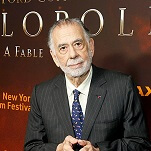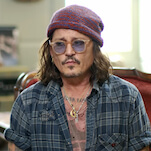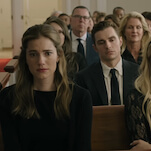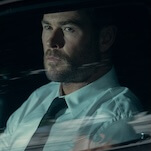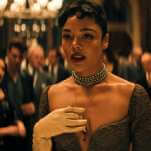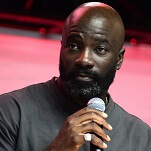Get On Up is the Hollywood biopic at its near-worst—a formless, extravagant assortment of historical incidents and lip-synched musical numbers, which ultimately amount to little more than a 138-minute showcase reel for Chadwick Boseman’s technically impressive and utterly opaque James Brown impression. Compared to Nelsan Ellis’ sympathetic take on Bobby Byrd in the same film, Boseman’s Godfather of Soul seems barely human, a collection of mannerisms and social tics wrapped in a loud suit and topped off with a wig. It’s pure animatronics.
The film’s achronological, flashback-within-flashback structure allows it to pilfer from plenty of other movies—a little Amadeus here, a little Ray there, and a whole lot of Walk The Line everywhere. (Not coincidentally, the movie it ends up resembling most is the music biopic spoof Walk Hard: The Dewey Cox Story.) It goes backward, forward, around, always circling back to Brown’s ability to wow any audience under any circumstances.
Here he is in 1968, performing for troops in Vietnam after stepping out of a burning transport plane. There he goes, singing to Byrd through the glass of a prison infirmary door in 1952. Now it’s 1955, and he’s literally stealing a show from Little Richard (Brandon Smith). Not even virulent racists are immune to the genius of James Brown; one scene, they’re complaining about having to share a hotel pool with his band, the next they’re dancing at the bar to the sound of his rehearsals. This is the redemptive, world-changing power of popular art, as conveyed through the ham-fisted style of Tate Taylor, director of The Help.
Of course, all of the music is great—but why shouldn’t it be? It’s wall-to-wall James Brown. But remove Brown’s name (and its extratextual connotations) and what you end up with is a confused, overlong dawdle of a movie with one dramatic scene—an argument about time signatures between Brown and Maceo Parker (Craig Robinson)—and a lot of bathetic boilerplate dressed up with period signifiers.
What does James Brown do when he isn’t knocking people on their asses with his music? He meets other famous people—the Rolling Stones, the aforementioned Little Richard, Lyndon B. Johnson (seen, conveniently, from the back), Frankie Avalon—and says their names out loud. Occasionally, a supporting character makes a remark that will appear ironic within the context of history.
When he isn’t playing music or meeting other stars and cultural icons, Brown finds himself being left, over and over: by his mother, Susie (Viola Davis); by his father, Joe (Lennie James), who dumps him on the doorstep of brothel madam Aunt Honey (Octavia Spencer); by his original band, the Famous Flames; by several generations of sidemen and backing vocalists; by Byrd. In trying to sell the viewer on Brown’s crowd-pleasing genius, sibling screenwriters Jez and John-Henry Butterworth have run up against a narrative problem: the man’s tendency to estrange or abuse nearly everyone who ever got close to him.
Taylor and the Butterworths preserve all of these incidents, but their attitude toward Brown himself is psychologically evasive, which makes most of the conflicts seem unmotivated. For instance, the 1988 high-speed chase that landed Brown in jail is used to frame many of the movie’s flashbacks, but the drug problems that led up to it—and defined Brown’s public image for the last decades of his life—are reduced to a single scene of the singer smoking a joint in his mansion. First, he’s eyeing second wife Deedee Jenkins (Jill Scott) dancing in the audience, and then he’s beating her while dressed in a Santa suit; the approach might be called “warts and all” if there was any “all” to speak of. Boseman’s tribute-act performance is distinguished by its splits and fancy footwork, but never suggests that there’s a psychology, however fractured, behind all the dance moves and halting speech rhythms. The only relationship that appears to exist on equal terms is the one Brown develops with promoter Ben Bart (Dan Aykroyd). But why?
Answering that question wouldn’t somehow turn Get On Up into a good movie, but the fact that it gets ignored points to the sheer caginess of its design. As with The Help, Taylor has picked an incredibly strong supporting cast—with Ellis given the closest thing the movie has to a dynamic role—and a broad topic, tried his best to gloss over any inherent difficulties or contradictions, and in the process created something that feels sophomoric and simplistic not just in regard to its subject, but to human behavior as a whole.







